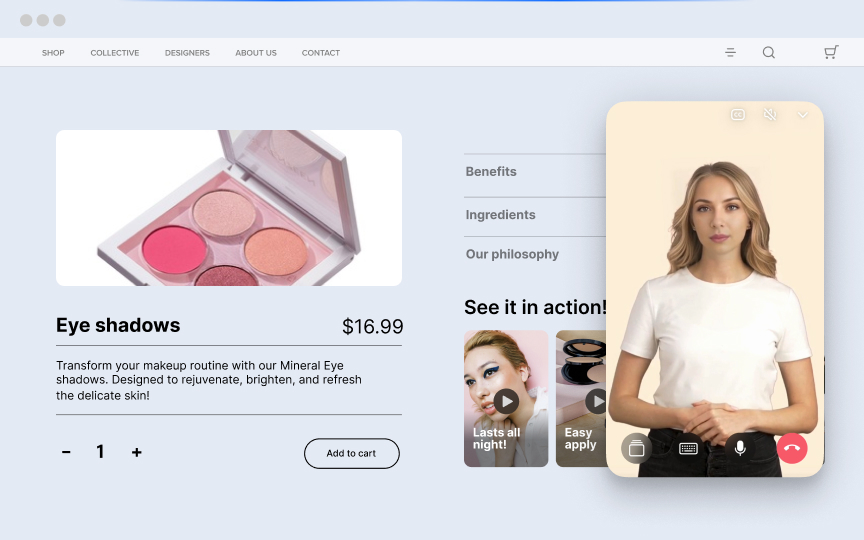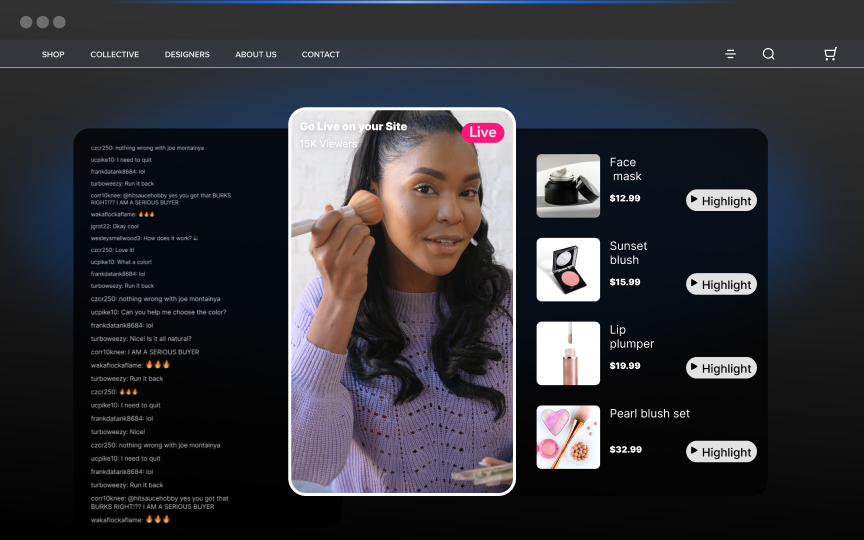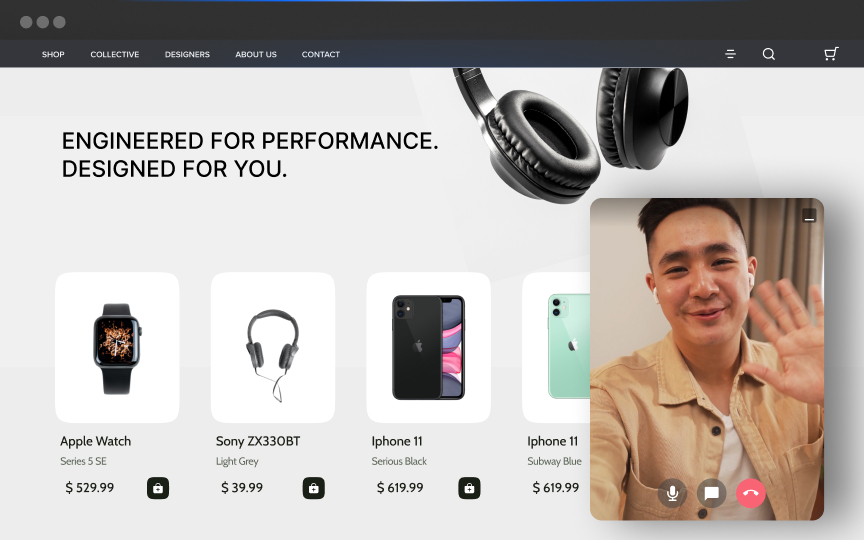Video has transformed e-commerce by bridging the gap between online shopping and in-store experiences. Product videos bring merchandise to life, showcasing features in ways static images simply cannot. With most consumers now checking videos before making purchases, implementing effective video strategies has become essential for e-commerce success.
Whether you're an established brand or just starting out, effective product videos in e-commerce can:
- Boost customer understanding
- Increase purchase confidence
- Reduce returns
- Drive more sales
Download our 2025 Fashion & Apparel Video Commerce Playbook to discover proven strategies for creating compelling videos that convert browsers into loyal customers.
Planning and Conceptualization in Product Videos for E-commerce
Creating an effective product video starts well before you pick up a camera. The planning phase sets the foundation for ensuring your video achieves its purpose and connects with your audience in the e-commerce space.
Setting Clear Objectives for Your Product Video
Before storyboarding or filming, establish what you want your video to accomplish. Creating videos without direction becomes an expensive habit.
Your objectives should connect to your business goals. Common video goals in e-commerce include:
- Increasing time on your website pages
- Generating new leads
- Boosting sales
- Improving conversion rates
When setting objectives, determine how you'll measure success. Establish key metrics upfront to evaluate your video campaign's impact and make data-driven decisions for future productions.
By clarifying your aims, you can direct your content strategy and create purposeful product videos in e-commerce rather than adding to digital noise.
Choosing the Right Products to Feature in Your E-commerce Videos
Not all products are equal when it comes to video marketing in e-commerce. When selecting items to showcase, consider:
- Product complexity: Items with unique features that aren't easily shown in static images make excellent video candidates.
- Visual appeal: Products with interesting textures, movements, or interactive elements often shine in video format.
- Customer interest: Focus on bestsellers or products that generate frequent questions.
- Video format alignment: Different products need different approaches:
- Demonstration videos work well for products with specific usage instructions.
- 360° spinning videos provide comprehensive views of physical items.
- Testimonial videos build credibility for high-consideration purchases.
Look at successful e-commerce brands for inspiration. Many use product videos as the primary showcase for their accessories, highlighting features and capacity in ways static images couldn't achieve.
Storytelling and Emotional Connection Strategies in E-commerce Videos
Great product videos go beyond features—they tell compelling stories that create emotional connections with viewers. When customers connect emotionally with your content, they're more likely to engage with your brand and buy.
To create an effective narrative:
- Structure your video with a clear arc: Include a beginning that identifies a problem, a middle that introduces your product as the solution, and an end showing the benefit.
- Show real-life applications: Rather than listing specifications, demonstrate how your product fits into everyday scenarios. Skincare videos can illustrate a morning routine that feels both aspirational and attainable.
- Focus on authenticity: Use relatable settings and people that resonate with your target audience.
- Incorporate customer stories: Tutorial videos can increase revenue per customer by up to 17%, while video testimonials significantly outperform written ones in conversion rates.
- Maintain consistent pace and tone: The rhythm of your video and the mood it conveys should align with your brand identity and message.
Remember that effective storytelling doesn't feel forced. Your narrative should help viewers imagine themselves using your product in a way that feels natural and compelling. This transforms your e-commerce video from a product showcase into a powerful conversion tool.
Types of Product Videos in E-commerce
Product videos in e-commerce showcase your offerings in engaging and informative ways. Different video types serve various purposes throughout the customer journey. Here's how each can boost your e-commerce marketing efforts.
Demonstrations
Demonstration videos show your product in action, highlighting key features and functionality. They answer the critical question: "How does this product work?"
A well-crafted product demonstration:
- Showcases specific attributes not easily visible in static images.
- Provides close-up shots from multiple angles to address purchase concerns.
- Helps customers visualize the product's benefits practically.
The impact is significant. Research shows that these videos can increase revenue per customer by 17%. They're especially effective for complex products where functionality isn't obvious from photos alone.
Tutorials
Tutorial videos go beyond basic demonstrations to provide step-by-step guidance on using a product effectively. These videos offer practical instruction while showcasing product benefits.
Effective tutorial videos:
- Provide detailed usage instructions in an easy-to-follow format.
- Help customers understand how to maximize value from their purchase.
- Create a sense of community among users with shared knowledge.
Tutorials are valuable for products requiring technical knowledge or offering multiple features. They serve as both pre-purchase convincers and post-purchase support, reducing return rates and support tickets.
According to research, 96% of shoppers rely on product videos when making buying decisions, with tutorials being particularly influential.
Reviews
Review videos come in two primary forms: brand-created testimonials and user-generated content. Both serve as powerful social proof that builds credibility and trust in e-commerce.
Brand testimonial videos feature satisfied customers sharing their experiences with your product. They:
- Illustrate real-world benefits and applications.
- Demonstrate how your product solves specific problems.
- Build trust through authentic customer stories.
User-generated reviews act similarly but with added authenticity since they're created independently. Studies show that 58% of consumers express more trust in brands that utilize videos over those that don't.
The impact of review videos is substantial. Customers who watch product videos are 1.7 times more likely to convert to paying customers than those who don't.
Unboxing
Unboxing videos capture the experience of opening and initially using a product. Typically user-generated, these videos provide an authentic first look at what customers can expect when their purchase arrives.
Effective unboxing videos:
- Show the packaging, contents, and initial setup process.
- Capture genuine first impressions and reactions.
- Give potential customers insight into the complete purchase experience.
Unboxing videos serve as a form of "virtual try-before-you-buy," helping reduce uncertainty in online purchases. Their popularity stems from their authenticity and the vicarious excitement they generate.
The impact extends to reduced return rates. Research by MediaPost suggests that 57% of shoppers return items less frequently and feel more confident in their purchases when product videos are available.
Technical Specifications and Production Quality in E-commerce Videos
Creating high-quality e-commerce video content doesn't require Hollywood-level budgets. With strategic planning and resource allocation, you can produce professional videos that deliver your message regardless of budget constraints.
Minimum Technical Requirements for Video Production
Understanding the baseline technical requirements will help you avoid common pitfalls:
Camera Equipment: While high-end cinema cameras produce stunning results, they're not essential for most marketing videos. Your options include:
- Smartphone cameras: Modern smartphones can capture impressive footage when properly stabilized on a tripod. This is your most budget-friendly option.
- DSLR or mirrorless cameras: For regular video production, investing in a decent camera ($500-$3000) can significantly elevate your content quality.
Audio Recording: Audio quality often matters more than video quality. Poor sound can immediately diminish viewer engagement, regardless of how beautiful your visuals are.
- Built-in microphones on cameras typically deliver subpar results.
- Smartphone audio recording apps can serve as an unexpected solution—place your phone near the speaker (out of frame) and sync the audio during editing.
- Affordable external microphones like lavalier mics (which clip onto your subject) or shotgun mics (which mount on cameras) dramatically improve audio clarity.
Location Considerations: Your shooting environment significantly impacts production quality:
- Prioritize quiet spaces with minimal echo.
- Seek locations with abundant natural light.
- Choose clutter-free, well-decorated areas that align with your brand image.
Budgeting Options for E-commerce Video Production
Your budget will determine your approach to video production, but quality content is achievable at any level:
DIY Approach (Under $1,000):
- Use smartphone cameras with tripods
- Record audio separately using phone apps or entry-level microphones
- Utilize natural lighting supplemented with affordable LED panels
- Edit with free or low-cost software
Mid-Range Production ($1,000-$5,000):
- Invest in a quality DSLR or mirrorless camera
- Purchase professional microphones and basic audio equipment
- Add a three-point lighting kit
- Consider hiring freelance specialists for specific aspects (editing, sound design)
Professional Production ($5,000+):
- Work with specialized equipment or hire a production company
- Bring in professional talent and crew
- Utilize premium editing services
- Access better locations and production resources
When calculating your total investment, remember to include all production expenses such as:
- Equipment rental or purchase costs.
- Talent and crew compensation.
- Location fees.
- Post-production editing.
- Staff time spent on planning and coordination.
Understanding the complete cost structure of video production helps you allocate your budget effectively and measure ROI accurately.
The Role of Lighting, Sound, and Editing in E-commerce Videos
These three elements often distinguish amateur videos from professional productions, regardless of budget:
Lighting:
- Natural light works well when placed in front of your subject
- Avoid bright backgrounds that underexpose your subject
- For indoor shoots, a three-point lighting kit eliminates shadows and adds dimension
- Maintain consistent lighting throughout your shoot—outdoor lighting changes dramatically over the course of a day
Sound:
- Position microphones as close to your subject as possible
- Be aware that even "quiet" environments harbor background noise
- For interviews or presentations, lavalier microphones provide clear, consistent audio
- Always record test audio before committing to a location
Editing:
- Learn basic camera terminology (ISO, aperture, shutter speed, white balance) to shoot footage that's easier to edit
- Maintain consistent visual styles throughout your project
- Use editing to enhance your message rather than distract from it
- Consider outsourcing complex editing tasks if they exceed your technical capabilities
By focusing on these fundamental aspects, you can create impressive e-commerce video content that accomplishes your marketing goals without exceeding your budget.
Optimization for Platforms and Devices in E-commerce
Creating a great e-commerce video is only half the battle. You need to optimize your videos for various platforms and devices to reach and engage your target audience effectively.
Optimizing Videos for Mobile Devices
Mobile optimization isn't optional—it's essential. With over 70% of video content consumed on smartphones, failing to optimize for mobile could significantly limit your video's impact and cost you valuable conversions.
To create truly mobile-friendly videos:
- Use vertical or square formats that maximize screen real estate on mobile devices.
- Keep text large and readable—think bold headlines with minimal body copy.
- Frame shots thoughtfully with close-ups to ensure your product is clearly visible on smaller screens.
- Compress your videos effectively without sacrificing quality.
- Ensure your platform supports adaptive streaming for different connection speeds.
Remember that loading speed directly impacts mobile engagement. Videos that take too long to load will likely be abandoned before they even start playing.
Cross-Platform Compatibility
Different platforms have different requirements and audience expectations. To maximize your video's reach, create variations tailored for specific platforms and uses.
This might involve:
- Adjusting aspect ratios for different platforms (16:9 for YouTube, 9:16 for TikTok, 1:1 for Instagram feed).
- Creating shorter cuts for platforms where brevity is key.
- Adapting brightness and exposure to maintain consistent brand aesthetics across platforms.
- Adding platform-specific elements like captions (which are essential on platforms where videos often play without sound).
Also ensure your videos display properly across various devices by testing them on different screen sizes and integrating them properly into your website design. According to UX research, videos should be integrated into image galleries with clear "play" icons rather than being isolated in separate tabs.
SEO in Video Titles and Descriptions
Video SEO can dramatically increase your content's visibility and effectiveness. In fact, 87% of marketers claim that video has helped them generate leads.
To optimize your e-commerce videos for search engines:
- Use relevant, keyword-rich titles and descriptions that accurately represent your content.
- Create compelling thumbnails that increase click-through rates.
- Add transcripts and captions to improve accessibility and provide additional text for search engines to crawl.
- Implement Video structured data on pages featuring your videos.
- Submit a video sitemap file to help Google locate all web pages with video content.
A Wistia study found that when their videos were indexed by Google, search traffic increased by 10.6% for one month. Well-optimized videos have the opportunity to appear in Google's featured video results, potentially leading to higher click-through rates and more traffic to your site.
Distribution and Placement Strategies for E-commerce Videos
Where and how you share your e-commerce videos is just as important as the content quality itself. Strategic positioning of video content can be the difference between a viewer scrolling past or clicking that purchase button.
Best Practices for Video Placement
The psychology behind video placement is fascinating—position your video too early, and you might overwhelm customers; too late, and you risk losing their interest. Here are some effective placement strategies:
- Product Pages: Embedding videos next to product descriptions gives potential customers a better understanding of your offerings, significantly increasing conversion likelihood.
- Homepage Placement: Feature videos on your homepage to create a dynamic first impression and immediately engage visitors.
- Category Pages: Videos here provide comprehensive, quick understanding of product categories, increasing click-through rates to product pages.
- Shopping Cart Integration: Placing videos within the checkout process can serve as a final persuasive push, reinforcing product value and reducing cart abandonment.
A notable case study of successful placement strategy comes from a tech-gadget store that strategically positioned product videos throughout their website. Their approach led to a significant increase in engagement and higher conversion rates across all placement points.
Remember that mobile compatibility is crucial—ensure your videos are easily viewable on smaller screens as more consumers shop via mobile devices.
Using Social Media for Wider Reach
To maximize your e-commerce videos' reach and impact, distribution across multiple channels is essential:
- Identify platforms where your target audience is most active and engaged.
- Adapt your videos to suit each platform's requirements (aspect ratios, lengths, formats).
- Include share buttons and clear prompts to encourage viewers to distribute your content.
- Extend your videos' lifespan by regularly resharing across different channels.
Your website is an excellent starting point, but avoid directly uploading videos as this can slow loading speeds. Instead, embed videos using third-party hosting providers.
Foster two-way communication by actively responding to comments and questions on your shared videos. This engagement strengthens relationships, builds trust, increases views, and offers insights into viewer preferences.
A/B Testing and Analytics for Optimal Placement
The most effective video placement strategy comes from continuous testing and optimization. What works for one product might not work for another:
- Test different placement positions on your website.
- Analyze engagement metrics for each placement variation.
- Measure performance across different devices and platforms.
- Adjust your strategy based on concrete results.
When conducting these tests, focus on key performance indicators like view duration, click-through rates, and most importantly, conversion rates. By systematically tracking how different placements affect these metrics, you can develop a refined, evidence-based approach to video distribution.
Remember that placement strategy should evolve with your audience's behavior patterns. Regularly revisiting and optimizing your approach ensures your e-commerce videos continue to have maximum impact along the customer journey.
Get expert placement strategies for fashion and apparel brands in our 2025 Video Commerce Playbook.
Measuring Performance and ROI of E-commerce Videos
Creating product videos is just the beginning. To truly understand the impact of your video marketing efforts, you need to track performance and calculate return on investment (ROI).
Key Performance Indicators (KPIs)
The first step in measuring video performance is selecting the right KPIs that align with your specific goals:
For Awareness campaigns, focus on:
- Views/Impressions: Total number of times your video is viewed
- Reach: Number of unique viewers who saw your video
- Website Visits: Track through UTM links or link click metrics from ad platforms
For Consideration stage content, monitor:
- Engagement Rate: Calculate by summing all engagements (likes, comments, shares), dividing by total views, and multiplying by 100
- Average View Duration: Shows how long viewers stay engaged
- Social Media Mentions: Track brand discussions
- Subscriber Growth: Measure increases in social followers or email subscribers
For Conversion focused videos, prioritize:
- Conversion Rate: Percentage of conversions divided by number of views
- Cost Per Conversion: Total campaign cost divided by number of conversions
I recommend establishing a measurement framework using your CRM system to cross-reference revenue data with video viewing metrics. This allows you to identify which videos are frequently viewed by contacts that ultimately convert into customers.
Leveraging User-Generated Content (UGC) in E-commerce
User-generated content has become a cornerstone of effective digital marketing strategies in e-commerce. When your customers create and share content about your brand, they're providing authentic endorsements that resonate deeply with potential customers.
Benefits of UGC
The power of UGC lies in its authenticity and trustworthiness:
- Enhanced Trust and Credibility: According to the Nielsen Consumer Trust Index, 92% of consumers trust organic UGC more than traditional advertising.
- Authenticity: 90% of consumers say authenticity is important when deciding which brands they like and support. UGC provides that genuine voice traditional marketing often lacks.
- Social Proof: Almost half (46%) of consumers trust online business reviews as much as personal recommendations from friends or family.
- Cost-Effectiveness: Utilizing content created by your audience significantly reduces expenses related to content production while maintaining authenticity.
- Improved SEO: Fresh and unique UGC helps enhance your brand's online presence and search engine ranking.
Strategies to Incorporate UGC in Your E-commerce Marketing
Integrating UGC into your marketing requires a thoughtful approach:
- Encourage Reviews and Testimonials: Over 70% of consumers consult product reviews before making a purchase. Consider offering incentives like coupons or reward points to motivate feedback.
- Create Hashtag Contests: Develop specific, memorable hashtags that prompt your audience to share content for a chance to win prizes. This increases engagement while building your content library.
- Leverage Employee-Generated Content: Your team members can provide an inside look at your company culture, offering authenticity while showcasing the people behind your brand.
- Implement a Systematic Approach:
- Audit existing customer content across platforms.
- Create campaigns specifically designed to generate customer content.
- Actively engage with participants to foster community.
- Monitor performance and adjust your strategy accordingly.
Examples of Successful UGC Campaigns in E-commerce
These brands have masterfully leveraged UGC to create memorable marketing moments:
- Coca-Cola's #ShareACoke: By printing various names on their bottles, Coca-Cola encouraged customers to find and share photos with bottles featuring their names or those of friends, creating personal connections with the brand.
- Apple's Shot on iPhone: This campaign showcases photos taken by iPhone users, highlighting the camera's quality while affirming users' contributions.
- Nike's #AirMaxDay: Each March 26th, Nike invites fans to share their favorite Air Max memories and styles, celebrating the product's legacy while letting users express their personal style.
- Aerie Real: Aerie's commitment to no longer retouch models prompted customers to share unretouched photos using #AerieREAL, generating thousands of authentic submissions that resonated with their audience.
Troubleshooting and Continuous Improvement in E-commerce Video Marketing
Creating and distributing video content inevitably comes with challenges. Understanding common issues and having strategies to overcome them will help you maintain a smooth production process and continuously improve your video marketing efforts.
Common Challenges and Solutions
When producing e-commerce marketing videos, you'll likely encounter several typical issues:
Audio Problems: Poor audio quality can ruin an otherwise excellent video. If you're struggling with unclear sound:
- Avoid using built-in camera microphones, which often produce subpar results
- Be mindful of background noise that might not be noticeable during filming but becomes distracting in the final product
- If budget is limited, use your smartphone as an audio recorder placed closer to your subject (out of frame), then sync the audio with your video in editing
- Consider investing in affordable lavalier or shotgun microphones for significantly better sound quality
Location Difficulties: The right shooting environment makes a tremendous difference in your final product. When dealing with location challenges:
- Choose naturally quiet spaces to minimize audio interference
- Seek locations with ample natural light to enhance video quality
- Avoid rooms with echo issues that can compromise audio clarity
- Ensure spaces are clean and free from distracting clutter
- For beginners, filming in your office can reduce stress and logistical complications
Post-Production Issues: The editing phase often reveals unexpected problems:
- Missing footage or the need for additional content may require re-shoots, which can be costly and time-consuming
- Disorganized clips can make editing unnecessarily complicated—maintain a clear labeling system
- Audio imbalance issues can be addressed by keeping dialogue around -12db and background music significantly lower
- When something isn't working in your edit, don't be afraid to experiment—mistakes are easily reversible in most editing software
Tools for Ongoing Improvements
Leveraging the right tools helps you continually refine your video marketing approach:
- Video Hosting Platforms: Services like Wistia, Vimeo, or YouTube provide not only distribution channels but also analytics to help you understand viewer engagement.
- Embedding Solutions: Rather than uploading videos directly to your website (which can slow loading times), use embedding options from hosting platforms to maintain site performance.
- Multi-Platform Adaptation Tools: Software that helps you optimize video formats, aspect ratios, and lengths for different distribution channels.
- Engagement Tracking: Analytics tools that monitor viewer interaction, helping you identify where viewers lose interest or engage most deeply.
Expert Insights for Refining Strategies
To continuously improve your e-commerce video marketing efforts:
- Maximize Cross-Platform Distribution: Extend your video's lifespan by posting content across multiple channels, adapting formats and messaging to suit each platform's requirements and audience preferences.
- Foster Audience Engagement: Actively respond to comments and questions on your videos to build relationships, increase trust, and gain valuable insights into viewer preferences.
- Balance Technical Elements Carefully: When editing, remember that restraint is often more effective than excess—avoid overusing transitions and effects that might distract from your core message.
- Implement Iterative Improvements: Use learnings from each video production to refine your process for the next one, gradually building a more efficient and effective workflow.
- Test and Measure: Experiment with different approaches to production and distribution, measuring results to identify what works best for your specific audience.
By systematically addressing challenges and implementing continuous improvements based on data and experience, you'll develop increasingly effective e-commerce video marketing content that resonates with your audience and achieves your business objectives.
Conclusion
The future of e-commerce will increasingly integrate immersive technologies like AR and VR, voice commerce, and hyper-personalization. These developments will further enhance the video shopping experience, making it even more intuitive and engaging.
By implementing the strategies we've discussed in this guide to product videos in e-commerce, you'll be well-positioned to meet customers where they are—seeking authentic, informative, and engaging content that helps them make confident purchasing decisions. The brands that embrace video commerce now will build the foundations for success in this rapidly evolving retail landscape.
Unlock Exclusive Insights
By submitting this form, you agree to Firework's privacy policy and consent to receive personalized marketing communications. You can unsubscribe at any time.































